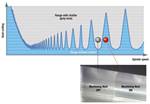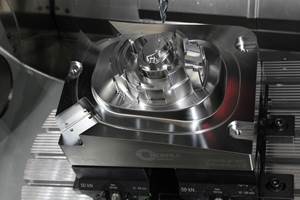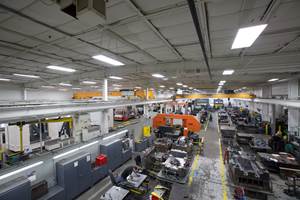Why Your Next VMC Should Be a HMC
High technology raises the bar for productivity gains.
Mold manufacturers often have one initial reaction when it comes to horizontal machining centers (HMCs). “Too expensive.” True, horizontal machining centers are traditionally more expensive—at the time of purchase—than vertical machining centers (VMCs). So how can this investment be justified? Can you really afford it?
Upon doing a thorough job of capturing the costs, the case can be made that most shops can’t afford not to include at least one HMC on the machine floor.
Prioritize Business Drivers
The practical need for new equipment typically crops up when the shop determines there’s a need to increase capacity. And while this may seem counterintuitive, capacity is not the best reason for buying new equipment.
First, consider the true business drivers that make or break profitability and viability of the company. These include increasing throughput and consistency, improving quality and efficiency, and creating a competitive advantage that brings in more orders. Plus, the main agenda on everyone’s mind these days—reducing overall operating costs. HMCs fit this bill nicely.
Utilization Differs Significantly
Let’s continue with capturing the true costs of the business. Spindle run time is a good measure of utilization, which in turn provides a good snapshot of throughput, efficiency and profitability.
Now here are some interesting facts about VMC and HMC usage. Recent surveys have demonstrated that average utilization for VMCs is a paltry 25 percent. (When we discuss the details of VMC processes later in this article, it will become clear why this is the case.) HMC utilization is routinely 85 percent. These numbers alone should command anyone’s serious attention.
VMC Versus HMC Practices
VMCs are optimally used for large flat parts requiring a single operation. However, most verticals across the industry are being used for small, prismatic parts. This presents a problem. If a part requires machining on six sides, it is moved by the operator seven times or more. Each part movement uses up available spindle time and requires direct labor input. This increases both costs and opportunities for quality problems. Labor costs are expensive, and often increasing in uncontrollable ways. Quality issues drain profits from any job.
When using a HMC, if a part requires machining on six sides, it is only touched by the operator three times, maximum. The load/unload is done while the machine is cutting. Four part moves requiring direct labor are eliminated completely. This results in productivity gains such as reduced labor costs, reduced quality problems and opportunity for unattended operation.
HMCs for Short Run Work
Historically, HMCs have been purchased for all these reasons, however primarily for longer run work. Can a HMC be the right machine for general, short run work? The key factor to consider is this: in many applications, you can replace three verticals with only one horizontal. Consider the cumulative reductions this has on manufacturing costs. Reduced capital investment and floor space requirements. Eighty-five percent spindle utilization instead of 25 percent. Shorter cycles and manufacturing throughput times. Set-ups and load/unload times are internal to machining cycles. Work-in-process can be cut by 75 percent or more (inventory control). Operator attendance time (direct labor) is greatly reduced.
MoldMaking Considerations
There are several circumstances particular to moldmakers where a HMC can provide efficiencies. Some processing scenarios involve batch machining, where parts are handled as a group. In the case of large parts, detail segments are used to split the job into portions of cavities, which are grouped together so they can be machined at the same time. Another example is gun drilling of base plates, where holes—some of which are deep—are drilled on one pallet. Operator intervention for these processes can be dramatically reduced. On a VMC, parts are moved from fixture to fixture seven to nine times; on a HMC this goes down to three moves per part. By regaining 30 percent of processing time, profitability is greatly increased.
Multiple Set-ups Versus Turning Capabilities
Traditional VMC processes may require a lathe with a special chuck, multiple VMC set-ups, highly-skilled operators and labor-intensive operator actions to complete turning operations. All of this drives high process costs. HMCs now have turning capabilities, and new technology (called Turn-Cut) allows for no special chuck and no special tooling or fixtures. Multiple machines are not needed, nor are multiple setups. There is considerably less need for operator attendance. Complete parts are produced with each machine cycle, with a reliable, repeatable and efficient process.
The Technology Imperative
Not long ago, our industry went through a seismic transformation that left many shuttered mold shops in its wake. Many people claim this was the result of cheap overseas labor, but this is not the case. It’s true that overseas labor is cheaper, but the skills for moldmaking are nearly non-existent in these markets. In reality, the formidable competition comes from the shops that bring in high-technology as the primary assets for gaining efficiencies, productivity and a competitive edge.
HMCs increase efficiency, reduce operating costs, grow the business and increase profitability. When the true costs of running VMCs are captured—the high expense of VMC fixturing, labor-intensive operator movements, low utilization, floor space requirements and dependency on high-cost labor—it’s clear these costs can spiral out of control.
When it comes to increasing capacity, one HMC costs less and requires a smaller footprint than multiple VMCs. This HMC machine investment can be amortized across multiple parts.
All things considered, HMCs provide a viable platform for the growth of the company by delivering productivity gains and therefore an enviable competitive edge. The leading companies of today and tomorrow will make their gains on technology strength, not strength of workforce. If capacity is your concern, consider this time-honored wisdom: If we don’t do something different, how can we expect different results?
Related Content
Ten Things You Need to Know about Circle Segment Milling
Considerations for evaluating if circle segment end mills or conical barrel cutters are right for your mold machining applications.
Read MoreDesign Strategy Tackles Big and Small Complexity Challenges for Southeastern Mold Builder
Delta Mold Inc.’s core values, engineering expertise, five-axis machines and molding capabilities help the team turn a proposal into a manufactured mold or part with custom design, finishing and assembly.
Read MoreSpeed, Productivity Gains and High Uptime Ease Decision for Second Five-Axis Machine
Byrne Tool + Design reduced setups and gained speed and productivity thanks to fast, accurate and compact five-axis CNC machining centers.
Read MoreRead Next
How to Eliminate Chatter
Here are techniques commonly used to combat chatter and guidelines to establish a foundation for optimizing the moldmaking process.
Read MoreHow to Use Strategic Planning Tools, Data to Manage the Human Side of Business
Q&A with Marion Wells, MMT EAB member and founder of Human Asset Management.
Read MoreHow to Use Continuing Education to Remain Competitive in Moldmaking
Continued training helps moldmakers make tooling decisions and properly use the latest cutting tool to efficiently machine high-quality molds.
Read More




















